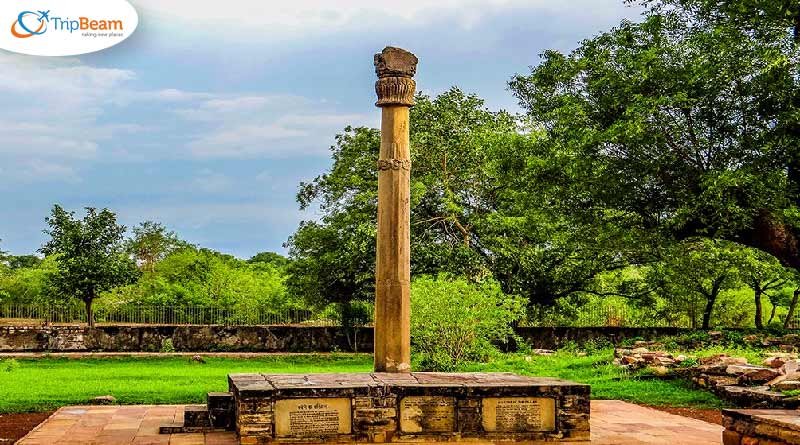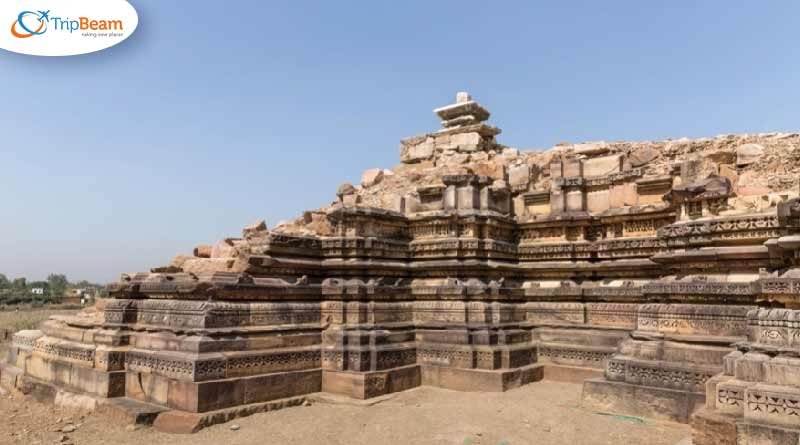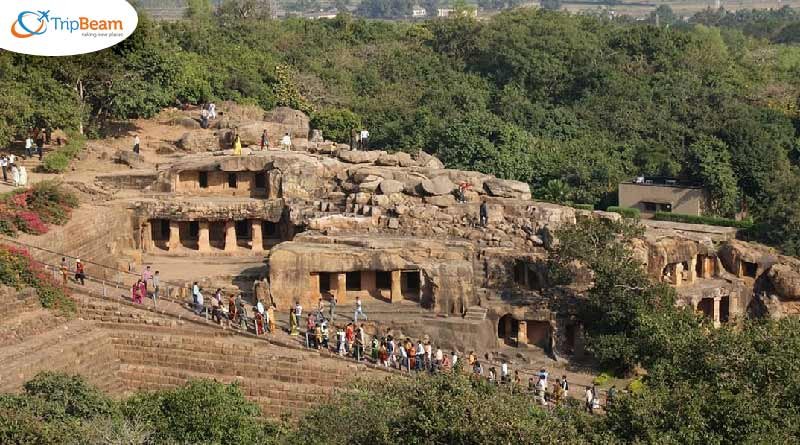
Vidisha was a major city in ancient India. It stood on the commercial route that connected north and south India. It appears in many ancient myths, particularly those involving traders. Aside from the iconic Sanchi Stupa, there are numerous notable and interesting places to visit in Vidhisha, such as the Udaigiri Caves. So, pack your bags, book your cheap flight tickets from USA to India, and plan for a trip with Tripbeam.us
Heliodorus Pillar
 The Heliodorus Pillar is located between the Vidisha and Udaigiri caves. It’s a little site, and many residents are unaware of its actual position. They may, however, inform you if you request ‘Khamb baba’. This is how the pillar is revered locally now. Heliodorus pillar is a Garuda Stambh, which is a pillar with the Garuda emblem on top, representing Sri Vishnu’s vehicle. According to mythology, the pillar was erected by Heliodorus, a Greek philosopher who converted to Hinduism while living here. He was the Greek ambassador to King Bhagabhadra of Vidhisha.
The Heliodorus Pillar is located between the Vidisha and Udaigiri caves. It’s a little site, and many residents are unaware of its actual position. They may, however, inform you if you request ‘Khamb baba’. This is how the pillar is revered locally now. Heliodorus pillar is a Garuda Stambh, which is a pillar with the Garuda emblem on top, representing Sri Vishnu’s vehicle. According to mythology, the pillar was erected by Heliodorus, a Greek philosopher who converted to Hinduism while living here. He was the Greek ambassador to King Bhagabhadra of Vidhisha.
According to the Brahmi inscription on the pillar, it was constructed in 150 BC. The inscription also mentions Vasudeva as God of the Gods. A subsequently uncovered inscription on the pillar references a line from the Mahabharata. The pillar appears to be standing alone in an enclosed ground. When we spoke with the locals, we learned some interesting anecdotes.
Beejamandal Temple Complex
 Beejamandal is a temple complex in the town of Vidisha. Few individuals are aware of it. No signs are directing you to this old location. It was built as a temple for Charchika Devi, a Durga avatar or, as some believe, Saraswati. Parmar King Navbarman erected it in the eleventh century. Aurangzeb destroyed it and turned it into a mosque. Following independence, it was taken over by ASI. Since then, it has only served as a monument.
Beejamandal is a temple complex in the town of Vidisha. Few individuals are aware of it. No signs are directing you to this old location. It was built as a temple for Charchika Devi, a Durga avatar or, as some believe, Saraswati. Parmar King Navbarman erected it in the eleventh century. Aurangzeb destroyed it and turned it into a mosque. Following independence, it was taken over by ASI. Since then, it has only served as a monument.
It’s a temple erected on a large platform similar to the one at Bhojpur. The damaged statues depict Hindu deities. Thousands of temple ruins, broken and damaged, lie scattered throughout the platform. Other sources refer to it as a Surya Temple, dedicated to the Sun God, or a Vijaya Mandir, established to commemorate a military victory.
Udaigiri Caves
 Cave temples were the first temples to exist before being built on land and higher platforms. These eventually evolved into diverse kinds of temple buildings. The Udaigiri Caves consist of approximately 20 Hindu and Jain cave temples on a hillside. Chandragupta II likely constructed the caves during the early Gupta dynasty, possibly in the late 4th or early 5th century, as indicated by the inscription found in Cave 6. This makes these caverns the oldest known and dated Hindu temples. It is sometimes referred to as Vishnupadagiri.
Cave temples were the first temples to exist before being built on land and higher platforms. These eventually evolved into diverse kinds of temple buildings. The Udaigiri Caves consist of approximately 20 Hindu and Jain cave temples on a hillside. Chandragupta II likely constructed the caves during the early Gupta dynasty, possibly in the late 4th or early 5th century, as indicated by the inscription found in Cave 6. This makes these caverns the oldest known and dated Hindu temples. It is sometimes referred to as Vishnupadagiri.
Udaigiri means “hill of the rising sun.” You can see similar hills in Rajgir, Bihar, and in Odisha, near Bhubaneshwar. Does this imply that it was once a Sun worship center? Probably yes. It also lies near the Tropic of Cancer, indicating its alignment with the movement of the Sun. Located near the junction of the Bes and Betwa rivers, this could have been a portion of Vidhisha, as mentioned in Kalidasa’s Meghdoota. With so many temples on a hill, it seemed possible that it was a hallowed pilgrimage. Archaeological evidence suggests that it was a city as far back as the sixth century BCE.
Claimants assert that the Iron Pillar, an engineering marvel at Delhi’s Qutub Minar Complex, originally stood at Udaigiri. Cave temples here show a square mandapa in front of the garbhagriha. Various caves contain pillars. Reliefs can be found on door jambs. Artisans have carved Murtis into recesses in the rock.Plan your trip from Canada to India with Tripbeam.ca and get the most affordable and the best deals.
Cave 5 at Udaigiri Caves
 Cave 5 is the most important piece of craftsmanship you’ll observe here. It features a massive sculpture of Vishnu’s Varaha Avatar on the wall. This is the caves’ distinctive sculpture. Vishnu, as Varaha, can picture himself clutching the ground like a woman. All of the deities surround him, such as:
Cave 5 is the most important piece of craftsmanship you’ll observe here. It features a massive sculpture of Vishnu’s Varaha Avatar on the wall. This is the caves’ distinctive sculpture. Vishnu, as Varaha, can picture himself clutching the ground like a woman. All of the deities surround him, such as:
Brahma on a lotus, Shiva on Nandi, slightly above the ground. The panels to the right of Varaha contain 12 Adityas, 8 Vasus, 11 Rudras, Agni, Vayu, and Rishis. Closer to the ocean’s bottom, one can observe Gupta rulers and their ministers. Varaha’s left features Shesha, while Lakshmi occupies the right. Positioned on the upper left are numerous sages, led by Narada, who holds his Vina.
Other Temples and Caves
Cunningham named Cave 6 Vina Cave because it contained a sculpture of a guy playing Vina. You can see Ganga and Yamuna on the door to this cave. Inside, there is an Ekmukhalinga or Shivalinga with only one face sculpted. Cave 13 contains a 3.66-meter-long sculpture of Sheshashayee Vishnu. You can observe something similar in the Undavalli Caves of Andhra Pradesh. Cave 19 features a carving of Sagar Manthan. Apart from that, despite the demolition of the majority, several temples dedicated to various Hindu deities still exist. Other caves are very plain, however, some have reliefs of Mahishasurmardini, Ganesha, and Matrikas.
The figures here have Greek features. So, either there was a lot of Greek influence in India at the period, or the artists were Greek, which explains the influence. It is also plausible that they were the general features, from which our current features emerged. On top of the hill lie the ruins of a Gupta-era temple. They also discovered a massive pillar, resembling the Ashoka pillar in Sanchi. On your way down, you will notice a rest house built by the king of Gwalior about 100 years ago. Also, if you are in a hurry, book your last minute international flight deals for a smooth experience.
Also Read: Want To Visit In Kerala? Check Out These Top 8 Locations For An Memorable Trip




